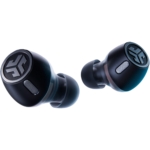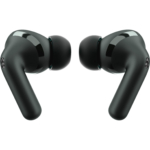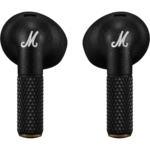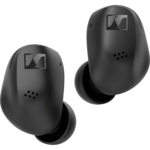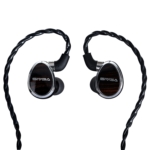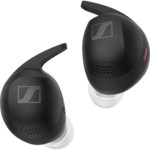The SPL Phonitor 2 is aimed at professional users who demand purely analogue equipment, that is equally audiophile and practical, for monitoring with headphones and loudspeakers in the recording studio.
In addition to impeccable workmanship, innovative technology and powerful performance, the unit is characterised by its outstanding sound, which resolves source signals in the frequency range, in space and dynamics in the best possible way, thus allowing an in-depth assessment – assuming the use of an equally good pair of headphones – playback that is decoupled from the room acoustics and plays at the highest level, and a magnifying glass for the evaluation of sound engineering work.
The Phonitor Matrix may be seen as a valuable tool for getting closer to the sound image of loudspeaker reproduction, thus offering the sound engineer a reliable basis for assessment when mixing with headphones, which most competitors lack. So if you are looking for the right partner for your high-quality headphones, the SPL Phonitor 2 gets our unreserved recommendation as a reference tool.
Flawless workmanship, innovative technology, powerful performance and outstanding sound: the SPL Phonitor 2 gets an unreserved recommendation as a partner for reference-level headphones.
SPL, from Niederkrüchten in North Rhine-Westphalia, has been active in the field of studio technology since 1983. The manufacturer, which has developed such innovative devices as the Vitalizer and the Transient Designer, now showcases a comprehensive range of products for studio use, mastering and audiophile music consumption, all of which are designed and manufactured in Germany.
The use of headphones in everyday music consumption has long since surpassed the classic home stereo system. As a result, there is a demand for audiophile headphones and headphone amplifiers as well as devices for professional use. The amplifier has a significant influence on the sound; it is always optimised for music reproduction, whereas the standard solutions in our smartphones or audio interfaces are often more of an add-on. So if you invest in a high-quality pair of headphones, you should consider suitable amplification to go with them.
The Phonitor 2 is the most elaborate SPL headphone amplifier from their studio range. I was immediately impressed by its elegant design and high-quality workmanship. The unit we tested, including the integrated power supply, weighs a little more than 4kg and is available in silver or black. It is about 28cm wide and, with its solid front panel, illuminated VU meters and a large motorised ALPS potentiometer for the volume (RK27), it certainly shares similarities with high-quality hi-fi components.
The successor to the first Phonitor, which SPL first introduced with the eponymous Phonitor Matrix in 2008, uses its own 120-volt technology, which is also found in the manufacturer’s mastering products. Specially developed operational amplifiers with a supply voltage of ±60 volts (to the manufacturer’s YouTube video) are used, and these should ultimately result in increased signal-to-noise ratio and improved dynamics. For comparison: conventional components/operational amplifiers work with an operating voltage of ±15 volts for the transformed DC voltage to amplify signals. On the measurement sheet, this results in a dynamic range of more than 136 dB and a signal-to-noise ratio of more than 103 dB. At the same time, the overload reserve is so high that the amplifier hardly ever has to operate at its limit in relation to the reference level. This promises good sound…
Functionality
Volume control is either manual or via a remote function which uses any infrared remote control and moves the volume control knob as if by magic. Two XLR and one RCA stereo input are available as sources, while for output you can choose between XLR line level and headphone output or a mute position. Next, there is a mono/stereo switch, which is useful when checking mono compatibility, such as for vinyl cutting, radio use, as well as for modern Bluetooth/WLAN speakers.
At the same time, there is a deliberately restrained balance (laterality) control of 2.25 dB with automatic level compensation. This makes sense for people with hearing impairments and specific hearing characteristics. Such weaknesses are partly compensated for by our hearing, but the compensation on the device makes it easier to work with.
Finally, the left and right channels can be listened to individually if necessary and their phase can be rotated with a second switch. This is useful for checking signal integrity in the studio, but, by combining with the mono switch, it allows you to monitor mid and side signals – a common challenge in studio and mastering work.
The Phonitor 2 is aimed at professional users. In addition to its function as a headphone amplifier, it also provides playback to studio control room monitors.
The primary headphone connection is a 6.3 mm jack, located on the front panel. The Phonitor 2 does not use special formats such as Pentaconn or XLR4, nor does it have a second output. The XLR socket at the rear is intended for output to (active) speakers. In principle, however, it can also be used for balanced headphones with an adapter cable.
Furthermore, there are several DIP switches on the bottom of the unit: these can be used to switch the outputs between different gain levels. For this purpose, it is possible to make the Phonitor Matrix usable for XLR outputs and to put the Phonitor 2 into a loop-through mode in order to pass the selected input signal through to the outputs unmanipulated (except for the switchable phase rotation).
SPL provides a useful option with the optional 19″ expansion rack. Here, the XLR output can be distributed via a switch to one of four XLR stereo outputs – ideal for multiple monitors. By the way, according to the manufacturer, the same option can also be used as a passive input expansion with matching cables.
The two stylish VU meters show the volume at all times. They can be configured according to the input level and are illuminated in different colours depending on the output selection.
Phonitor Matrix
The Phonitor 2’s special feature is the switchable, fully equipped Phonitor Matrix. The aim of this is to match the specific sound of headphones, which conceptually deliver a different and often more intensive panorama width and spatial reproduction due to their perfect channel separation, compared to reproduction on loudspeakers (to the manufacturer’s explanatory video on YouTube). For audio assessment but also for “honest” reproduction, this is quite welcome, as one assumes that the majority of music has been mixed for loudspeaker reproduction.
The Phonitor Matrix offers filtered crosstalk between the channels (increasingly above 500 Hz), which can be up to 30 per cent, with a “Crossfeed” parameter that can be switched in six stages. At the same time, the angle of the “virtual” speakers can be set in six steps between 15 and 75 degrees. Here you control the so-called “interaural time difference”, which is between 90 and 635 microseconds, depending on the angle. An additional level compensation of the centre signal (centre level) for the correct embedding of the stereo centre after applying the crossfeed parameter can also be adjusted on this model in six steps up to a reduction of -2 dB. This parameter can also be switched off. SPL offers listening examples at this link, which you should listen to with headphones.
In practice
The Phonitor 2’s task is straightforward, and this also applies to its operation. Besides source selection, you can decide on the desired output, volume and use of the Phonitor Matrix. The other switching options are more likely to be used occasionally. The output power is impedance-dependent between 1 watt (32 ohms), 2.7 watts (600 ohms) and 5 watts (250 ohms) per channel. In addition, the output level can be increased by a further 12 dB via a dip switch.
My only criticism of the equipment is the absence of the option to use headphones and speaker output simultaneously. The Phonitor 2 is also rather unsuitable for headphone comparisons. This is where the RME ADI-2 Pro FS has a clear advantage.
Sound
Our sound assessment was mainly done with the portable DAP M3X from Shanling,magnetostatic headphones Peacock from Sendy Audio and theHD 800 S from Sennheiser. The Phonitor 2 coped well with both headphones and offered a completely adequate power reserve.
The result was playback with an absolutely coherent sound, which amplified the sound sources with all their details and exemplary fast responses that were completely neutral and without side noises, thus ultimately bringing out the characteristics of the sound source as well as of each pair of headphones.
The Phonitor 2 did not gloss over anything and so also revealed weaknesses in the source material, provided the appropriate headphones were used. Harshness, imbalances, dynamic limitations, editing errors, as well as flat or spatially unfavourable mixes, were revealed.
Dynamics were excellent, but so was the coherence of complex productions ranging from orchestral classical to pop, jazz and metal. Kraftwerk’s “Radioactivity” (3-D), for example, sounded outstanding in terms of space and stereo panorama, while on “Midnatssdans” (Benny Andersson: piano) every individual touch on the Fazioli grand piano was surrounded by an audible space and had clearly comprehensible dynamics.
However, this quality means that bass, for example, is reproduced in a more controlled manner than on typical home systems or club sound systems. The sound engineer can benefit from greater control when evaluating their decisions, but this requires knowledge of how this reproduction chain translates to other systems. However, this isn’t something you can really fault SPL for.
Admittedly: A good headphone amplifier should make a minimum difference in the outlined playback chain. SPL uses all its resources to ensure the highest possible quality. Compared to more simple systems or the majority of integrated solutions, a sonic advantage is recognisable. In practice, this is experienced as better resolution, but also in the form of a significantly later onset of listening fatigue. Listening to music and working with the Phonitor 2 not only sounds outstanding but is also fun and can be enjoyed for hours – a quality criterion in a professional environment.
At the same time, the Phonitor 2 justifies its premium over many competitors with the Phonitor Matrix and practical switching options. The Phonitor Matrix itself sounds coherent and natural, but the result depends on the source material. In general, the mix moves forward and loses some of the width typical of headphones. This has an impact on the level ratios and is thus quite relevant in practice.
This brings the reproduction via loudspeakers closer: the midrange is strengthened, and reverberation spaces recede further into the background. Depending on the track, clear differences can sometimes be noticed, especially in the stereo panorama but also in the sound colour and the level ratios. It should be clear, without making a judgement, that you can hear a different audio treatment. And consequently, it seems to me that it also makes sense to choose the Phonitor Matrix as a reference for working with headphones when it comes to creating a mix for speakers via headphones (or even just listening to the mix as authentically as possible).
When doing this, it makes sense to allow yourself a period of familiarisation. Quick A/B comparisons are not advisable. And once you have become accustomed to the Phonitor Matrix, you may find the “spectacular” sound image of a pair of headphones unnatural in terms of the panorama.
A close comparison was made with the models already tested. SPL divides their headphone amplifiers into a studio range for professional users and those for audiophile music listeners (Professional Fidelity). The main difference between the Phonitor 2 and models Phonitor se and Phonitor xe is a different functionality that addresses each target market. However, the technology used, based on operational amplifiers with ±60 volts (VOLTAiR), is completely identical.
The closest comparison is the Phonitor X model (to the manufacturer’s product page) – a headphone amplifier that can also work as a preamplifier before a power amplifier. If required, it offers an integrated D/A converter, an XLR-4 headphone output, power amp outputs in RCA and XLR format as well as control outputs for switching compatible power amps on and off. There are trade-offs with a less complete Phonitor Matrix, the number of XLR inputs, and functionality when listening to individual stereo channels.
Technical specifications
- Ear couplingAmplifier
- TypeDesktop
- Frequency response (headphones)(-3dB): 10 Hz - 300.000 Hz
- Weight without cable4.300 g
Special features
- Available in black and silver
- Phonitor Expansion Rack: 379 €
- View all technical data on the manufacturer's page












